(仅供参考)抗生素中相关杂质质量标准制定的指导原则【中英】
抗生素类药品杂质限度标准

抗生素类药品杂质限度标准《抗生素类药品杂质限度标准》随着现代医学的发展,抗生素类药品在临床应用中的重要性越来越被认识到。
然而,抗生素类药品在生产过程中可能会产生一些杂质,这些杂质可能对患者的健康造成影响,因此制定了抗生素类药品杂质限度标准,以确保药品的质量和安全性。
抗生素类药品的杂质主要分为有机杂质和无机杂质两类。
有机杂质包括有机溶剂残留物、杂质与活性成分相关的化合物、光谱杂质等。
有机溶剂残留物指生产过程中使用的溶剂残留下来的成分,这些溶剂可能对人体产生毒性作用。
杂质与活性成分相关的化合物是指与药物活性成分有一定化学关系的杂质,这些化合物可能影响药物的疗效或产生不良反应。
光谱杂质主要指药物在生产过程中产生的未知化合物,这些化合物难以被鉴定和定量,因此需要对其进行限制。
无机杂质主要包括重金属和无机盐类。
重金属是指铅、铬、汞等对人体有毒的金属元素。
这些重金属可能通过药物吸收进入人体,对肝脏、肾脏等器官造成损害。
无机盐类包括磷酸盐、硫酸盐等,虽然无机盐类一般不会对人体造成直接伤害,但过高的含量可能影响药物的稳定性和药效。
制定抗生素类药品杂质限度标准的目的是为了保证药品的质量和安全性。
这些标准根据药品的特性和临床应用的需要制定,严格限制了有机杂质和无机杂质的含量。
在药品生产过程中,需要进行严格的质控,确保药品的质量符合标准要求。
同时,在药品上市后,还需要进行药品的质量监测,确保药品的质量在正常范围内。
抗生素类药品杂质限度标准的制定与药品监管部门、药品生产企业以及科研机构密切相关。
这些组织通过不断的研究和实验,不断完善和更新抗生素类药品杂质限度标准,以确保患者在使用抗生素类药品时的安全性和有效性。
总之,抗生素类药品杂质限度标准的制定对于保障药品的质量和安全性至关重要。
通过限制有机杂质和无机杂质的含量,可以确保患者在使用抗生素类药品时不受到不良反应的影响,从而促进临床治疗的有效进行。
此外,药品监管部门、药品生产企业和科研机构也需要持续的努力,不断完善相关的标准和规范,以确保抗生素类药品的质量和安全性得到有效的保障。
抗生素指导原则

其中我国(如大肠杆菌达 其中我国(如大肠杆菌达20%,幽门螺杆菌 ,幽门螺杆菌80%) ) 结核菌在80年代由于采用四联疗法和短程治疗, 结核菌在 年代由于采用四联疗法和短程治疗,人们期望能消灭结 年代由于采用四联疗法和短程治疗 流行, 核,但随AIDS流行,疫情迅速回升,且出现多重耐药,WHO不得 但随 流行 疫情迅速回升,且出现多重耐药, 不得 不在93年宣布全球紧急状态 不在 年宣布全球紧急状态
• 2004年8月9日,中华人民共和国卫生部、国家中医药管理局、 年 月 日 中华人民共和国卫生部、国家中医药管理局、 中国人民解放军总后勤卫生部正式发布施行。 中国人民解放军总后勤卫生部正式发布施行。
抗菌药物临床应用指导原则
• 目的为推动合理使用抗菌药物、规范医疗机构和医务 目的为推动合理使用抗菌药物、 人员用药行为。 人员用药行为。 • 要求各级各类医疗机构和医务人员应认真学习,贯彻 要求各级各类医疗机构和医务人员应认真学习, 执行。 执行。 • 达到提高我国感染性疾病的抗菌治疗水平,减缓细菌 达到提高我国感染性疾病的抗菌治疗水平, 耐药性的发展,降低医药费用。 耐药性的发展,降低医药费用。
抗生素中相关杂质质量标准制定的指导原则【中英】

30 June 2012EMA/CHMP/CVMP/QWP/199250/2009 corrCommittee for Medicinal Products for Human Use (CHMP)/ Committee for Medicinal Products for Veterinary Use (CVMP)Guideline on setting specifications for related impurities in antibiotics抗生素中相关杂质质量标准制定的指导原则Final 定稿学习之名(译注)Table of contents 目录Executive summary1. Introduction (background)2. Scope3. Legal basis4. General requirements5. Impurity profiling and reporting, identification and qualification thresholds6. New applications and variations7. Specifications for medicinal products8. Analytical proceduresDefinitionsAnnex 1: Explanatory note regarding thresholds.Annex 2: ThresholdsAnnex 3: Example of “fingerprint chromatogram” approach to control very complex impurity profiles 概要1、背景介绍2、范围3、法规依据4、一般要求5、杂质分布以及报告、鉴别和界定阈值6、新申请和变更7、制剂产品质量标准8、分析方法定义附件1:关于阈值的注释附件2:阈值附件3:利用基于“指纹图谱”的方法对非常复杂的杂质分布进行控制举例Executive summary 概要Antibiotics active substances currently on the market are produced by fermentation, by fermentation followed by one or more synthetic steps (semi-synthetic substances) or by chemical synthesis. Fermentation processes are, in comparison to synthetic processes, more variable and less controllable, so the impurity profile of an active substance whose manufacturing process involves fermentation may be more complex and less predictable than that of a purely synthetic product. For this reason fermentation products and semi-synthetic substances are not included in the scope of the ICH Q3 and the VICH GL10/GL11 guidelines, which set thresholds for the identification, reporting and qualification of related impurities in active substances manufactured by chemical synthesis.目前上市的抗生素类活性物质是由发酵、发酵加一步或几步合成步骤(半合成)、化学合成制得。
抗生素应用的指导原则
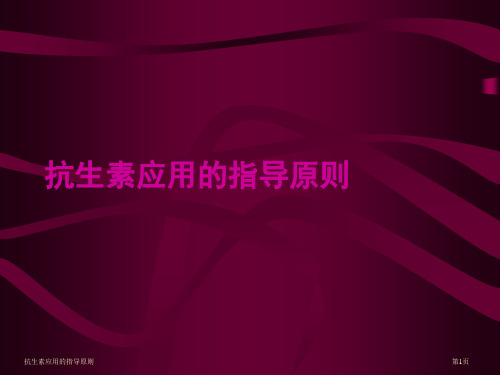
抗生素应用的指导原则
第23页
(11)嗜麦芽假单胞菌 复方新诺明,多西环素,新一代氟喹诺酮
(12)支原体: 大环内酯类,氟喹诺酮,四环素类
(13)衣原体 大环内酯类、四环素类 、利福平
抗生素应用的指导原则
第24页
2.专科感染
(1)幽门螺杆菌: 常见: 阿莫西林+灭滴灵+铋剂 最新: 新大环内酯(克拉霉素、阿奇霉素)+灭滴灵+铋剂。 (2)胆道感染 药选: I代头孢+甲替硝唑、喹诺酮+甲替硝唑 替补: III代头孢+甲替硝唑
(6)流脑(脑膜炎双球菌) 首选: 青霉素800~1200万u/d、严重万u/d 如青霉素过敏 ,次选: 氯霉素,头孢曲松,头孢噻肟。
抗生素应用的指导原则
第27页
(7)钧端螺旋体 青霉素
(8)孕妇 首选: 青霉素类 次选: 头孢类
抗生素应用的指导原则
第28页
(9)巨细胞病毒 首选: 更昔洛韦+静脉免疫球蛋白(IVIG) 或巨细胞病毒高免疫球蛋白。 替换: 磷甲酸钠可代替更昔洛韦。
Ampc大肠杆菌属、绿脓杆菌、不动杆菌。
抗生素应用的指导原则
第16页
5.普通经验性治疗 (1)小区取得性肺炎(CAP)
门诊病人CAP
无心肺疾病
有心肺疾病
或限制原因
或限制原因
新大环内酯类 β内酰胺类+大环内酯类
或多西环素
或单用呼吸系统氟喹诺酮类
抗生素应用的指导原则
第17页
住院病人CAP
轻中度CAP
复方磺胺嘧啶(SD+TMP)。
抗生素应用的指导原则
第11页
联适用药 (1)协同作用:1+1、1+2。 (2)累加作用 2+3.3+4。 (3)无关作用。 (4)拮抗作用。
Guideline on setting specifications for related impurities in antibiotics-中文
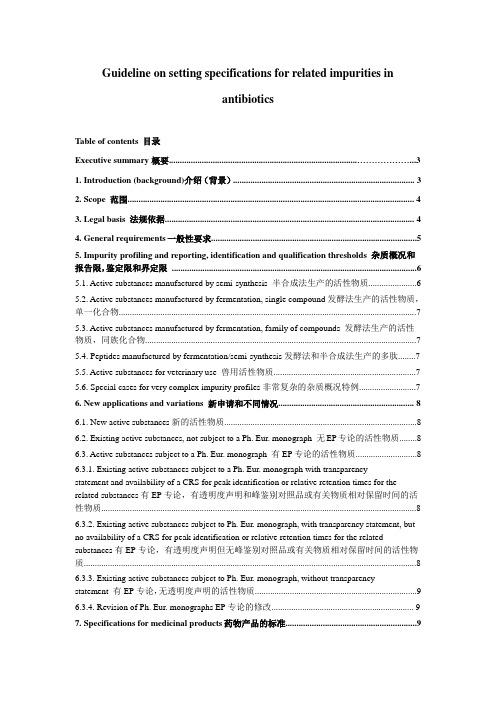
Guideline on setting specifications for related impurities inantibioticsTable of contents 目录Executive summary概要 (3)1. Introduction (background)介绍(背景) (3)2. Scope 范围 (4)3. Legal basis 法规依据 (4)4. General requirements一般性要求 (5)5. Impurity profiling and reporting, identification and qualification thresholds 杂质概况和报告限,鉴定限和界定限 (6)5.1. Active substances manufactured by semi-synthesis 半合成法生产的活性物质 (6)5.2. Active substances manufactured by fermentation, single compound发酵法生产的活性物质,单一化合物 (7)5.3. Active substances manufactured by fermentation, family of compounds 发酵法生产的活性物质,同族化合物 (7)5.4. Peptides manufactured by fermentation/semi-synthesis发酵法和半合成法生产的多肽 (7)5.5. Active substances for veterinary use 兽用活性物质 (7)5.6. Special cases for very complex impurity profiles非常复杂的杂质概况特例 (7)6. New applications and variations 新申请和不同情况 (8)6.1. New active substances新的活性物质 (8)6.2. Existing active substances, not subject to a Ph. Eur. monograph 无EP专论的活性物质 (8)6.3. Active substances subject to a Ph. Eur. monograph 有EP专论的活性物质 (8)6.3.1. Existing active substances subject to a Ph. Eur. monograph with transparencystatement and availability of a CRS for peak identification or relative retention times for the related substances有EP专论,有透明度声明和峰鉴别对照品或有关物质相对保留时间的活性物质 (8)6.3.2. Existing active substances subject to Ph. Eur. monograph, with transparency statement, but no availability of a CRS for peak identification or relative retention times for the related substances有EP专论,有透明度声明但无峰鉴别对照品或有关物质相对保留时间的活性物质 (8)6.3.3. Existing active substances subject to Ph. Eur. monograph, without transparency statement 有EP专论,无透明度声明的活性物质 (9)6.3.4. Revision of Ph. Eur. monographs EP专论的修改 (9)7. Specifications for medicinal products药物产品的标准 (9)8. Analytical procedures分析方法 (10)Definitions定义 (10)References 参考文献 (11)Annex 1: Explanatory note regarding thresholds附录1:有关限度的注释 (12)Annex 2: Thresholds附录2:限度 (13)Annex 3: Example of “fingerprint chromatogram” approach to control very complex impurity profiles 附录3:“指纹图谱”方法来控制非常复杂的杂质概况的示例 (14)Executive summary 概要(略)1.Introduction (background) 介绍(背景)(略)2.Scope (范围)本指南提供上市批准申请中,设定抗生素(如抗菌物质)的有关杂质的指导意见,这些抗生素是发酵产品或由发酵产品衍生的半合成物质。
国家抗生素用药指导原则
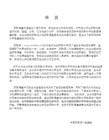
一、诊断为细菌性感染者,方有指征应用抗菌药物
根据患者的症状、体征及血、尿常规等实验室检查结果,初步诊断为细菌性感染者以及经病原检查确诊为细菌性感染者方有指征应用抗菌药物;由真菌、结核分枝杆菌、非结核分枝杆菌、支原体、衣原体、螺旋体、立克次体及部分原虫等病原微生物所致的感染亦有指征应用抗菌药物。缺乏细菌及上述病原微生物感染的证据,诊断不能成立者,以及病毒性感染者,均无指征应用抗菌药物。
4. 需长程治疗,但病原菌易对某些抗菌药物产生耐药性的感染,如结核病、深部真菌病。
5. 由于药物协同抗菌作用,联合用药时应将毒性大的抗菌药物剂量减少,如两性霉素B与氟胞嘧啶联合治疗隐球菌脑膜炎时,前者的剂量可适当减少,从而减少其毒性反应。联合用药时宜选用具有协同或相加抗菌作用的药物联合,如青霉素类、头孢菌素类等其他β内酰胺类与氨基糖苷类联合,两性霉素B与氟胞嘧啶联合。联合用药通常采用2种药物联合,3种及3种以上药物联合仅适用于个别情况,如结核病的治疗。此外必须注意联合用药后药物不良反应将增多。
3. 根据患者肾功能减退程度以及抗菌药物在人体内排出途径调整给药剂量及方法。
(二)抗菌药物的选用及给药方案调整:根据抗菌药物体内过程特点及其肾毒性,肾功能减退时抗菌药物的选用有以下几种情况。
1. 主要由肝胆系统排泄或由肝脏代谢,或经肾脏和肝胆系统同时排出的抗菌药物用于肾功能减退者,维持原治疗量或剂量略减。
《指导原则》共分四部分,一是“抗菌药物临床应用的基本原则”,二是“抗菌药物临床应用的管理”,三是“各类抗菌药物的适应证和注意事项”,四是“各类细菌性感染的治疗原则及病原治疗”。对上述内容有以下几点说明。
1、本《指导原则》为临床应用抗菌药物获取最佳疗效,并最大程度避免或减少不良反应而制定,不是教材或参考书,也不涉及具体的给药方案。
药品质量标准指导原则

第十五章药品质量标准的制订第一节概述一、药品质量标准制订的目的和意义(一)、药品质量标准是国家对药品质量、规格及检验方法所作的技术规定,是生产、供应、使用、管理等部门必须共同遵循的法定依据。
(二)、对发展医药事业,提高社会、经济效益,促进国际交流等具有重要意义。
二、标准的分类(一)、国家药品标准:中国药典,药品标准(为法定标准)(二)、临床研究用药品质量标准1、保证临床用药安全和临床结论的可靠.2、用于临床研究用的药品与实验研究用的供试品是否为同一物质,并有相似的性质。
3、供给临床试验用的各批药品是否有恒定的质量水平.4、供给临床的药品是否能代表或基本上代表今后放大投产的质量水平.5、仅供研制单位与临床试验单位使用。
(三)、暂行或试行药品标准1、报试生产时-----(经临床试验后)暂行药品标准。
2、正式生产时——---(经暂行药品标准执行两年后)试行药品标准.该标准执行两年后,如果质量好的再转为国家标准。
3、临床—暂行—试行—法定标准(四)、企业标准1、高于法定标准。
2、常规检验中采用较简易的方法来替代。
三、药品质量标准制订的原则(一)、安全有效-——坚持质量第一,从人民利益出发,结合生产实际和临床使用实际情况,使制定的质量标准能真正反映药品内在质量,对药物疗效影响大的或毒性较大的杂质应严格控制.(二)、先进性—-—采用国内外新成果、新技术、新方法,达到或超过国外标准,但也要考虑国内实际水平。
(三)、针对性---根据生产和使用情况,有针对性地规定检查项目和确定合理的限度,并考虑使用要求。
(四)、规范化-———按照国家药监局制订的基本原则,基本要求,一般格式进行。
(五)、综上所述,药品质量标准的制订必须体现:“安全有效、技术先进、经济合理、不断完善”的原则。
四、制订药品质量标准的基础(一)、文献资料的查阅与整理.(二)、了解有关研究资料,如:化学结构、理化常数,合成工艺,晶型,精制方法,制剂工艺,辅料等。
《抗生素《指导原则》》课件

预防性使用抗生素仅限于某些 特定情况,如预防术后切口和 手术部位感染等。
在预防性使用抗生素时,应严 格掌握适应症,选择适当的药 物和给药时机,避免滥用。
注意抗生素的剂量和用药时间
抗生素的使用剂量和用药时间直接关 系到治疗效果和不良反应的发生。
用药时间过短也难以保证治疗效果, 而用药时间过长则可能增加耐药菌株 产生的风险。
剂量不足会导致治疗效果不佳,而剂 量过大则可能导致不良反应增加。
03
抗生素滥用的危害
耐药性的产生
抗生素滥用会导致细菌产生耐药性,使抗生素失去效力,从而增加了治疗难度和医 疗成本。
耐药性的产生还可能使某些抗生素在特定情况下变得无效,甚至可能导致某些疾病 的无法治愈。
耐药性的产生是一个全球性的问题,需要采取有效的措施来遏制抗生素的滥用。
肝肾功能不全的患者应避免使 用对肝肾有毒性的抗生素,如 四环素类、磺胺类药物等。
妊娠期和哺乳期妇女应选用对 胎儿和婴儿无害的抗生素,如 青霉素类、头孢菌素类等。
老年人和儿童在使用抗生素时 应根据其生理特点和药物代谢 动力学特点选择合适的抗生素
。
避免不必要的使用和预防性使用
不必要的抗生素使用不仅会增 加耐药菌株的产生,还会增加 不良反应和药物相互作用的风 险。
利用媒体平台
利用媒体平台,如电视、 广播、报纸、网络等,广 泛宣传抗生素合理使用的 知识和重要性。
06
总结与展望
总结抗生素合理使用的重要性和必要性
抗生素是治疗感染性疾病的重要药物, 合理使用抗生素可以有效预防和治疗感
染性疾病,提高医疗质量和安全。
不合理使用抗生素会导致耐药性的产生 ,使抗生素失去疗效,增加患者治疗难
抑制蛋白质合成
《中华人民共和国药典(2015年版)》(二部)中抗生素类药品部分的增、修订情况介绍

《中华人民共和国药典(2015年版)》(二部)中抗生素类药品部分的增、修订情况介绍裘亚;刘浩;杨美成【摘要】The trend of the quality control of antibiotics is discussed through an introduction to the main changes related to standards of antibiotics in Pharmacopoeia of the People’s Republic of China (2015 version) volume II. This is of beneift not only to the implementation of new pharmacopoeia, but also to deifning an direction for the amendments of the quality standards of antibiotics in the future.%通过介绍《中华人民共和国药典(2015年版)》(二部)中抗生素类药品部分的增、修订情况,分析抗生素类药品质量标准的变化趋势。
这不仅有益于《中华人民共和国药典(2015年版)》的实施,而且也明确了今后抗生素类药品质量标准的增、修订方向。
【期刊名称】《上海医药》【年(卷),期】2016(037)007【总页数】4页(P5-8)【关键词】《中华人民共和国药典(2015年版)》;抗生素类药品;增;修订【作者】裘亚;刘浩;杨美成【作者单位】上海市食品药品检验所抗生素室/微生物室上海 201203;上海市食品药品检验所抗生素室/微生物室上海 201203;上海市食品药品检验所抗生素室/微生物室上海 201203【正文语种】中文【中图分类】R921.2《中华人民共和国药典(2015年版)》(以下简称为“2015年版《中国药典》”)已自2015年12月1日起正式实施。
9102药品杂质分析指导原则

药品杂质分析指导原则本原则用于指导药品质量标准中化学合成或半合成的有机原料药及其制剂的杂质分析,并供药品研究、生产、质量标准起草和修订参考。
任何影响药品纯度的物质均称为杂质。
药品质量标准中的杂质系指在按照经国家有关药品监督管理部门依法审查批准的规定工艺和规定原辅料生产的药品中,由其生产工艺或原辅料带人的杂质,或在贮存过程中产生的杂质。
药品质量标准中的杂质不包括变更生产工艺或变更原辅料而产生的新的杂质,也不包括掺人或污染的外来物质。
药品生产企业变更生产工艺或原辅料,并由此带进新的杂质对原质量标准的修订,均应依法向有关药品监督管理部门申报批准。
药品中不得掺入或污染药品或其组分以外的外来物质。
对于假劣药品,必要时应根据各具体情况,可采用非法定分析方法予以检测。
1.杂质的分类按杂质化学类别和特性,杂质可分为:有机杂质、无机杂质、有机挥发性杂质。
按其来源,杂质可分为:一般杂质和特殊杂质。
一般杂质是指在自然界中分布较广泛,在多种药物的生产和贮藏过程中容易引入的杂质,如铁盐、铵盐等。
特殊杂质是指在特定药物的生产和贮藏过程中引人的杂质,多指有关物质。
按其毒性,杂质又可分为:毒性杂质和信号杂质,毒性杂质如重金属、砷盐;信号杂质如气化物、硫酸盐等,一般盐无毒,但其含量的多少可反映药物纯度和生产工艺或生产过程问题。
由于杂质的分类方法甚多,所以,药品质量标准中检査项下杂质的项目名称,应根据国家药典委员会编写的《国家药品标准工作手册》的要求进行规范。
如有机杂质的项目名称可参考下列原则选用。
(1)检查对象明确为某一物质时,就以该杂质的化学名作为项目名称,如磷酸可待因中的“吗啡”,气贝丁酯中的“对气酚”,盐酸苯海索中的“哌啶苯丙酮”,盐酸林可霉素中的“林可霉素B”以及胰蛋白酶中的“糜蛋白酶”等。
如果该杂质的化学名太长,又无通用的简称,可参考螺内酯项下的“巯基化合物”、肾上腺素中的“酮体”、盐酸地芬尼多中的“烯化合物”等,选用相宜的项目名称。
(完整版)抗生素应用指导原则
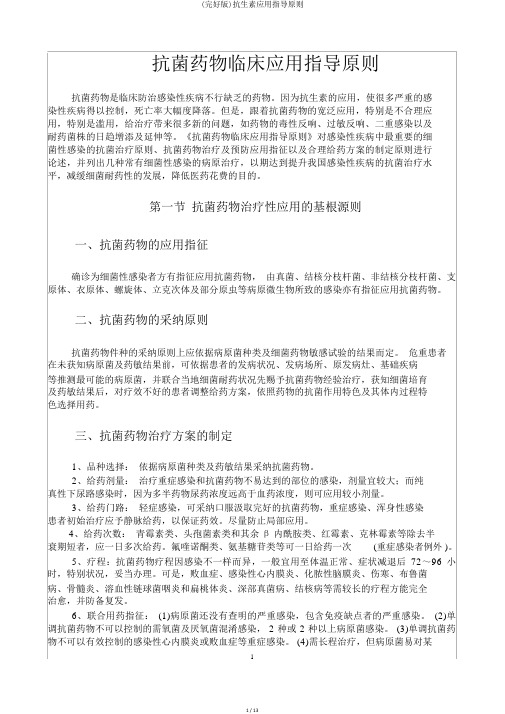
抗菌药物临床应用指导原则抗菌药物是临床防治感染性疾病不行缺乏的药物。
因为抗生素的应用,使很多严重的感染性疾病得以控制,死亡率大幅度降落。
但是,跟着抗菌药物的宽泛应用,特别是不合理应用,特别是滥用,给治疗带来很多新的问题,如药物的毒性反响、过敏反响、二重感染以及耐药菌株的日趋增添及延伸等。
《抗菌药物临床应用指导原则》对感染性疾病中最重要的细菌性感染的抗菌治疗原则、抗菌药物治疗及预防应用指征以及合理给药方案的制定原则进行论述,并列出几种常有细菌性感染的病原治疗,以期达到提升我国感染性疾病的抗菌治疗水平,减缓细菌耐药性的发展,降低医药花费的目的。
第一节抗菌药物治疗性应用的基根源则一、抗菌药物的应用指征确诊为细菌性感染者方有指征应用抗菌药物,由真菌、结核分枝杆菌、非结核分枝杆菌、支原体、衣原体、螺旋体、立克次体及部分原虫等病原微生物所致的感染亦有指征应用抗菌药物。
二、抗菌药物的采纳原则抗菌药物件种的采纳原则上应依据病原菌种类及细菌药物敏感试验的结果而定。
危重患者在未获知病原菌及药敏结果前,可依据患者的发病状况、发病场所、原发病灶、基础疾病等推测最可能的病原菌,并联合当地细菌耐药状况先赐予抗菌药物经验治疗,获知细菌培育及药敏结果后,对疗效不好的患者调整给药方案,依照药物的抗菌作用特色及其体内过程特色选择用药。
三、抗菌药物治疗方案的制定1、品种选择:依据病原菌种类及药敏结果采纳抗菌药物。
2、给药剂量:治疗重症感染和抗菌药物不易达到的部位的感染,剂量宜较大;而纯真性下尿路感染时,因为多半药物尿药浓度远高于血药浓度,则可应用较小剂量。
3、给药门路:轻症感染,可采纳口服汲取完好的抗菌药物,重症感染、浑身性感染患者初始治疗应予静脉给药,以保证药效。
尽量防止局部应用。
4、给药次数:青霉素类、头孢菌素类和其余β内酰胺类、红霉素、克林霉素等除去半衰期短者,应一日多次给药。
氟喹诺酮类、氨基糖苷类等可一日给药一次(重症感染者例外 )。
FDA对药物杂质的控制要求

Common Forced Degradation Conditions 常见强 制降解条件
0.1N HCl , 室温-100℃,4小时 0.1N NaOH,室温-100℃,4小时 1-3% H2O2, 室温,4小时 H2O, 100℃,4小时 15小时(相当于波长范围为300-800nm,约2.0百万勒克斯时 60 ℃,14天 40 ℃/75%RH,14天 15小时(相当于波长范围为300-800nm,约2.0百万勒克斯时
原料药与成品药中的有机杂质
药品中有机杂质的分类
– 有机杂质
特定杂质(Specified Impurities):特定杂质是指在质量标准中分别规定了明确的 限度,并单独进行控制的杂质。特定杂质包括化学结构已知的杂质(Specified Identified Impurity) 和化学结构未知(Specified Unidentified Impurity)的杂质。 美国药典通常采用代号来指认特定杂质,如相关化合物A(Related Compound A) 等。
MeOH, EtOH, IPA, THF, Dichloromethane, Acetone,
Triethylamine, etc.
• Residual Solvents/OVI’s
Solvents/reagents used in the reactions, purification process or formed during reaction
降解产物(Degradation Product):来源于原料药通过各种不同的化学反应途径的降 解,一般需要结合对合成路线的分析和试验研究的结果,以确定某一杂质是否为降 解产物。
有的有机杂质既是合成杂质,又是降解产物。
(整理)化学药品原料药质量研究和质量标准制定指导原则.
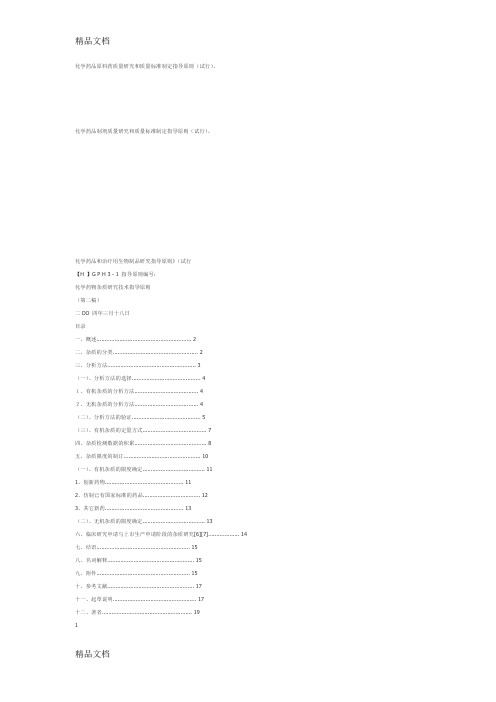
化学药品原料药质量研究和质量标准制定指导原则(试行)。
化学药品制剂质量研究和质量标准制定指导原则(试行)。
化学药品和治疗用生物制品研究指导原则》(试行【H 】G P H 3 - 1 指导原则编号:化学药物杂质研究技术指导原则(第二稿)二ΟΟ 四年三月十八日目录一、概述 (2)二、杂质的分类 (2)三、分析方法 (3)(一)、分析方法的选择 (4)1、有机杂质的分析方法 (4)2、无机杂质的分析方法 (4)(二)、分析方法的验证 (5)(三)、有机杂质的定量方式 (7)四、杂质检测数据的积累 (8)五、杂质限度的制订 (10)(一)、有机杂质的限度确定 (11)1、创新药物 (11)2、仿制已有国家标准的药品 (12)3、其它新药 (13)(二)、无机杂质的限度确定 (13)六、临床研究申请与上市生产申请阶段的杂质研究[6][7] (14)七、结语 (15)八、名词解释 (15)九、附件 (15)十、参考文献 (17)十一、起草说明 (17)十二、著者 (19)1一、概述任何影响药物纯度的物质统称为杂质。
杂质的研究是药品研发的一项重要内容。
它包括选择合适的分析方法,准确地分辨与测定杂质的含量并综合药学、毒理及临床研究的结果确定杂质的合理限度。
这一研究贯穿于药品研发的整个过程。
由于药品在临床使用中产生的不良反应除了与药品本身的药理活性有关外,还与药品中的杂质有关。
例如,青霉素等抗生素中的多聚物等高分子杂质是引起过敏的主要原因。
所以规范地进行杂质的研究,并将杂质控制在一个安全、合理的范围之内,将直接关系到上市药品的质量及安全性。
本指导原则是在参考国外相关指导原则的基础上,结合我国新药研发的实际情况制定的。
目的是为我国的药品研究提供有益的指导,从而提高药品的质量,保证人民的用药安全。
由于新药研究是探索性很强的工作,每种药品的具体研究情况差异很大,本指导原则不能涵盖杂质研究的所有情况,故仅提供了一个基本的研究思路和方法。
抗生素应用的指导原则课件

1950年代,相继发现了 氯霉素、土霉素等抗菌药。
1970年代,头孢菌素类 抗生素出现。
02
抗生素应用指导原则
合理使用抗生素的重要性
01
抗生素是治疗感染性疾病的重要 药物,但过度或不合理的使用可 能导致细菌耐药性的产生,影响 治疗效果。
02
合理使用抗生素可以减少不必要 的药物暴露,降低不良反应的发 生率,同时避免资源浪费和医疗 成本的增加。
头孢菌素类
通过抑制细菌细胞壁的合成发 挥杀菌作用,对G+菌、G-菌
均有较强作用。
大环内酯类
通过抑制蛋白质合成发挥抑菌 作用,主要针对G+菌和支原
体。
氨基糖苷类
通过抑制蛋白质合成发挥杀菌 作用,对G-菌作用强大,但 对肾和听神经有一定的毒性。
抗生素的发展历程
1942年,青霉素的发现 和应用开启了抗生素治疗 的新纪元。
典型病例二:不规范使用抗生素的后果
总结词
不规范使用抗生素可能导致耐药性的产生,增加治疗难度和医疗成本,甚至危及生命。
详细描述
在另一个典型病例中,患者因感冒引起的咳嗽、流涕等症状,自行购买并使用了抗生素。 由于没有按照医生的建议使用抗生素,且没有完成足够的疗程,导致感染未能得到有效 控制。随着时间的推移,患者体内的细菌产生了耐药性,对多种抗生素都不再敏感。最
根据感染的严重程度和病原体类型,制定 适当的疗程,确保感染得到有效控制。
抗生素的联合应用指导原则
联合用药指征
在某些特定情况下,如严重的混合感染或病原体不明时, 可能需要联合使用抗生素以提高治疗效果。
药物相互作用
联合使用的抗生素之间可能存在相互作用,应了解其药代 动力学和药效学特点,确保联合用药的安全性和有效性。
欧盟抗生素杂质指导原则

欧盟抗生素杂质指导原则引言:抗生素是一类重要的药物,用于治疗和预防细菌感染。
然而,抗生素在生产和使用过程中可能会受到杂质的影响,从而降低其质量和疗效。
为了确保抗生素的安全性和有效性,欧盟制定了抗生素杂质指导原则,旨在规范抗生素的生产和使用过程,以确保抗生素产品的质量和安全性。
一、杂质的定义和分类抗生素杂质是指在抗生素生产和使用过程中可能存在的不纯物质或其他物质,它们与抗生素分子结构不同,可能对人体产生不良影响。
根据欧盟抗生素杂质指导原则,抗生素杂质主要分为以下几类:1. 有机杂质:包括有机溶剂残留、有机酸、酮类、醚类等有机化合物;2. 无机杂质:包括金属离子、无机盐和其他无机化合物;3. 微生物杂质:包括细菌、真菌和其他微生物;4. 残留溶剂:指在抗生素生产过程中使用的溶剂,如甲醇、丙酮、二氯甲烷等;5. 其他杂质:包括不属于以上分类的其他杂质。
二、抗生素杂质限制为了确保抗生素产品的质量和安全性,欧盟抗生素杂质指导原则对抗生素杂质的含量进行了限制。
具体限制值根据抗生素的种类和用途而有所不同。
例如,对于口服抗生素,残留有机溶剂的限制值通常在10 ppm以下;对于注射用抗生素,残留有机溶剂的限制值通常在 5 ppm以下。
此外,欧盟还对微生物杂质进行了限制,要求抗生素产品中不能检出细菌和真菌。
三、抗生素杂质控制措施为了控制抗生素杂质的含量,欧盟抗生素杂质指导原则提出了一系列控制措施,包括但不限于以下几个方面:1. 原料选择:选择高质量的原料,确保原料中的杂质含量低;2. 生产工艺优化:优化抗生素的生产工艺,减少杂质的产生和残留;3. 杂质检测:建立有效的杂质检测方法,对抗生素产品进行定期检测,确保符合杂质限制要求;4. 清洁和消毒:确保生产设备和容器的清洁和消毒,避免杂质的污染;5. 质量管理体系:建立完善的质量管理体系,包括质量控制、质量保证和质量监控,确保抗生素产品的质量和安全性;6. 严格遵守法规:遵守欧盟相关法规和标准,确保抗生素产品符合质量要求。
抗生素杂质指导原则
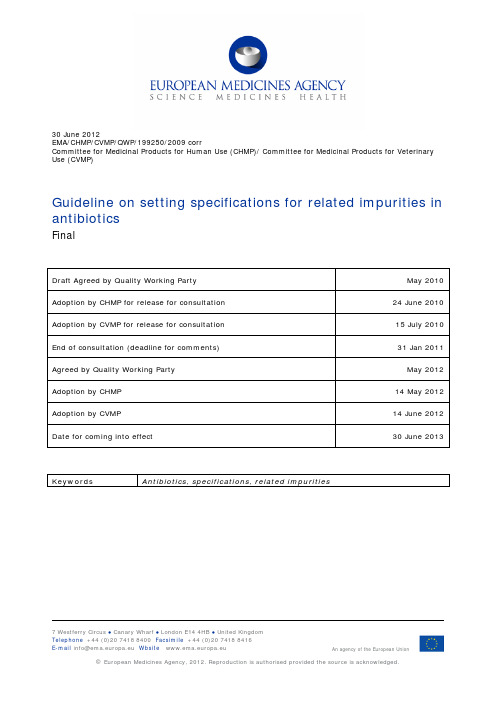
7 Westferry Circus ● Canary Wharf ● London E14 4HB ● United Kingdom30 June 2012 EMA/CHMP/CVMP/QWP/199250/2009 corr Committee for Medicinal Products for Human Use (CHMP)/ Committee for Medicinal Products for Veterinary Use (CVMP) Guideline on setting specifications for related impurities in antibioticsFinal Draft Agreed by Quality Working PartyMay 2010 Adoption by CHMP for release for consultation24 June 2010 Adoption by CVMP for release for consultation15 July 2010 End of consultation (deadline for comments)31 Jan 2011 Agreed by Quality Working PartyMay 2012 Adoption by CHMP14 May 2012 Adoption by CVMP14 June 2012 Date for coming into effect30 June 2013KeywordsAntibiotics, specifications, related impuritiesGuideline on setting specifications for related impurities in antibioticsTable of contentsExecutive summary (3)1. Introduction (background) (3)2. Scope (4)3. Legal basis (4)4. General requirements (5)5. Impurity profiling and reporting, identification and qualification thresholds (6)5.1. Active substances manufactured by semi-synthesis (6)5.2. Active substances manufactured by fermentation, single compound (7)5.3. Active substances manufactured by fermentation, family of compounds (7)5.4. Peptides manufactured by fermentation/semi-synthesis (7)5.5. Active substances for veterinary use (7)5.6. Special cases for very complex impurity profiles (7)6. New applications and variations (8)6.1. New active substances (8)6.2. Existing active substances, not subject to a Ph. Eur. monograph (8)6.3. Active substances subject to a Ph. Eur. monograph (8)6.3.1. Existing active substances subject to a Ph. Eur. monograph with transparency statement and availability of a CRS for peak identification or relative retention times for the related substances (8)6.3.2. Existing active substances subject to Ph. Eur. monograph, with transparency statement, but no availability of a CRS for peak identification or relative retention times for the related substances (8)6.3.3. Existing active substances subject to Ph. Eur. monograph, without transparency statement (9)6.3.4. Revision of Ph. Eur. monographs (9)7. Specifications for medicinal products (9)8. Analytical procedures (10)Definitions (10)References (11)Annex 1: Explanatory note regarding thresholds (12)Annex 2: Thresholds (13)Annex 3: Example of “fingerprint chromatogram” approach to control very complex impurity profiles (14)Executive summaryAntibiotics active substances currently on the market are produced by fermentation, by fermentation followed by one or more synthetic steps (semi-synthetic substances) or by chemical synthesis. Fermentation processes are, in comparison to synthetic processes, more variable and less controllable, so the impurity profile of an active substance whose manufacturing process involves fermentation may be more complex and less predictable than that of a purely synthetic product. For this reason fermentation products and semi-synthetic substances are not included in the scope of the ICH Q3 and the VICH GL10/GL11 guidelines, which set thresholds for the identification, reporting and qualification of related impurities in active substances manufactured by chemical synthesis.This guideline has been developed in order to provide guidance on how specifications for related impurities in antibiotics that are fermentation products or semi-synthetic substances derived from fermentation products, and are therefore not included in the scope of the (V)ICH guidelines mentioned above, should be set.Thresholds are given in the guideline for reporting, identification and qualification of related impurities for antibiotics medicinal products whose active substance is produced by fermentation or semi-synthesis. In cases where the active substance consists of a mixture of closely related compounds, where it may be difficult to apply general thresholds, general guidance is given on how to set specific thresholds and specifications and on how to qualify impurity profiles. The relationships between the requirements in the guideline and the applicable Ph.Eur. chapters and monographs are also addressed.1. Introduction (background)Most of the antibiotics currently on the market are produced by fermentation or chemical synthesis. In certain cases the chemical structure of the antibiotics obtained by fermentation is further modified by some synthetic steps, before the substance is used as an active substance in the manufacture of medicinal products (semi-synthetic substances).Fermentation processes involve biological systems which are less predictable, less controllable and more complex than straightforward chemical reactions. Because of this, the variability in products derived by fermentation is often greater than in products derived by chemical synthesis. Thus, the impurity profile of a fermentation product may be more complex and less predictable than that of a synthetic product.For this reason, fermentation products and semi-synthetic substances derived from them are not included in the scope of the ICH Q3 and the VICH GL10/GL11 guidelines that set thresholds for the identification, reporting and qualification of related impurities in active substances manufactured by chemical synthesis. These thresholds are defined in the guidelines as limits above which an impurity has to be either identified, reported or qualified, and the same limits are applied in the Ph.Eur. general monograph ‘Substances for Pharmaceutical Use’. Fermentation products and their semi synthetic derivatives are also excluded from the scope of this general monograph.In the absence of other guidance, related impurities in these products have been assessed on a case-by-case basis, which has resulted in the acceptance of different impurity thresholds for the same antibiotic and for different compounds within the same class (e.g. cephalosporins). There is also a need to ensure that the authorisation of new antibiotics is enabled by consistent approaches in setting limits for their impurities.It is therefore necessary to provide guidance, based on current practice and experience, to formulate general recommendations for impurity thresholds in antibiotics produced by fermentation or semi-synthesis. These are presented in this guideline.Even so, it is acknowledged that in some cases higher thresholds may be acceptable if necessary and justified taking account of use and exposure of the drug substance/product. This would also include analytical problems (see Annex 1: Explanatory note regarding thresholds).2. ScopeThis document provides guidance for marketing authorisation applications on setting specifications for related impurities in antibiotics (i.e. antibacterial substances) that are fermentation products or semi-synthetic substances derived from fermentation products. It is foreseen to widen the scope to other antibiotics (e.g. antifungal substances) at a later stage.It provides guidance for the content and qualification of related impurities in both active substances and medicinal products. The guideline is not intended to apply to new active substances used in investigational medicinal products used in clinical trials.In this guideline thresholds are given for reporting, identification and qualification of related impurities. For antibiotics where the active substance consists of a mixture of closely related compounds where it may be difficult to apply these general thresholds, general guidance is given on how to set thresholds and specifications and how to qualify impurity profiles. The thresholds given in this guideline would represent a general set of requirements, and this could be subject, for specific substances or products, to adaptation to the specific situation. Further requirements might be introduced when considered necessary, e.g. for safety reasons.This guideline does not cover residues from the fermentation process, i.e. residues from the producer micro-organism, culture media, substrates and precursors; this is covered by the Ph.Eur. general monograph ‘Products of fermentation’. (This monograph applies to substances manufactured by fermentation only, and not to substances manufactured by semi-synthesis).This guideline applies to new active substances and for new sources of existing active substances. It is the Applicant’s responsibility to demonstrate that the active substance has already been marketed in the EU when relevant.The guideline should not be applied retrospectively, but it is intended that this guideline will act as a stimulus to establish best practice and to initiate the revision of relevant Ph.Eur. monographs (i.e. for registered products revised requirements according to the monograph will apply when the monograph is introduced/revised). For new sources of existing active substances this guideline should be read in conjunction with any existing Ph.Eur. monograph for the active substance. It should be noted that comparison with impurity levels/profiles of active substance sources or products approved in the EU is one of the options for qualifying impurities.It is foreseen to re-evaluate the Scope when more experience has been obtained.3. Legal basisThis guideline has to be read in conjunction with the introduction and general principles (4) and part 1 of the Annex Is to Directives 2001/82/EC and 2001/83/EC as amended.4. General requirementsThe impurity profile depends very much on the manufacturing process; even for the same strain of a micro-organism, impurity profiles may be different. In general, purification steps including column chromatography and ultra-filtration steps may be crucial to achieve a sufficiently pure active substance.Semi-synthetic substances are not within the scope of the Ph.Eur. general monograph ‘Products of fermentation’. However, the specification of the fermented starting material should be justified with reference to current guidance, including general concepts described in this general monograph, if necessary. (The thresholds in this guideline are not intended to apply for fermented starting materials).The shorter the synthetic route after the fermentation and the more complex the fermented starting material, the more relevance the general monograph has. Therefore, a detailed description of the fermentation steps as well as other aspects addressed in the general monograph, in particular purification steps, should be presented for semi-synthetic antibiotics, unless justified by the non-complexity of the fermented starting material and the number and/or nature of the synthetic steps following fermentation.These synthetic steps should contribute to a relevant depletion and inactivation of fermentation by-products in the final active substance, so for example, esterification, etherification and salification of fermentation products (e.g., erythromycin derivatives like erythromycin ethylsuccinate or erythromycin lactobionate) are not considered as significant synthetic steps which would justify an omission of a detailed description of the fermentation process, in particular of the purification.In cases where the fermented starting material is not complex and taking into consideration the number and nature of the synthetic steps after fermentation, it may be sufficient to have a suitable specification for the fermented starting material including assay, component distribution (if relevant) and related impurities (specified, unspecified, and total). This should be in any case justified. For active substances manufactured by semi-synthesis, the impurity profile of the fermented starting material should be critically evaluated for its contribution to the impurity profile of the final active substance. Related impurities observed after fermentation include by-products, intermediates and degradation products. For semi-synthesis the impurities also include the fermented starting material and related substances in this starting material, synthesis by-products (including those derived from impurities in the starting material), synthesis intermediates and degradation products.Specifications should be given for any critical intermediates (this also includes intermediates between different purification steps). These specifications should include limits for specified and single unspecified impurities. Impurities that contribute to the impurity profile of the active substance should be specified. The applicant should provide a discussion on potential impurities, how they are removed and which impurities appear in the active substance.Even if manufactured by fermentation or semi-synthesis, an antibiotic may be structurally well defined as a mono component substance, and thus it may be efficiently purified. For each class of antibiotic, it is considered preferable to optimise purification steps as far as possible, in order to decrease the level of impurity to below the qualification threshold, than to provide (additional) safety data.For antibiotics manufactured by fermentation, the active substance may consist of a mixture of closely related compounds that show the relevant biological activity. In such cases it may be difficult to decide whether a compound is part of the active substance or should be regarded as an impurity when setting specifications (e.g. gentamicin). The definition of which substances are components of the activesubstance should be based on pre-clinical and clinical studies unless the active substance is described in a Ph. Eur. monograph where the active substance components are defined. Related compounds that are not defined to be components of the active substance are regarded as related impurities.The thresholds given in the ICH Q3 and VICH GL10/GL11 guidelines and in the guideline ‘Chemistry of New Active Substances’ (CPMP/QWP/130/96 Rev 1, EMEA/CVMP/541/03) do not apply to fermentation products and semi-synthetic substances derived from fermentation products. For other aspects, where specific guidance is not given in the present guideline, reference is made to the principles described in these guidelines.In qualifying an impurity or a given impurity profile at the level specified, several possibilities exist: appropriate battery of non-clinical tests, literature based data; comparison with impurity levels/profiles of active substance sources/products approved in the EU; or proving that the relevant impurity is a significant metabolite of the active substance.5. Impurity profiling and reporting, identification and qualification thresholdsFor antibiotic drug substances, the impurity profile should be characterised according to the guidance described in ICH Q3A (VICH GL10).In accordance with that guidance, with respect to related substances, limits should be set for:•Each specified identified impurity;•Each specified unidentified impurity;•Any unspecified impurity, with an acceptance criterion of not more than the identification threshold;•Total impurities.Exceptionally, if it is shown that it is not practically possible to identify an individual impurity, sufficient evidence of its structure should be provided (e.g. by HPLC/mass spectrometry to show that it may be satisfactorily classified as a related substance of the parent compound. In this case, it should be specified using an appropriate analytical marker e.g. HPLC Relative Retention Time (RRT), as a specified unidentified impurity. As a general principle, for impurities which are not structurally closely related (see section 5.3 below) to the parent compound, thresholds as given by ICH Q3A (VICH GL10) should be applied unless stated differently in the following sections.For the reasons discussed in section 4 above, and taking into account that the duration of treatment with antibiotics is in most cases limited, for antibiotic related substances the thresholds to be applied may be higher than those stated in ICH Q3A/VICH GL10, and also different for each of the different classes of antibiotic. These thresholds are given below.5.1. Active substances manufactured by semi-synthesisSemi-synthetic substances are obtained from a fermented starting material by a process involving at least cleavage and formation of covalent bonds and including extraction/purification steps. Acceptance criteria for related impurities should be set in accordance with the thresholds given below.The ICH Q3A thresholds for reporting, identification and qualification apply.Reporting threshold: 0.05%/0.03%Identification threshold: 0.10%/0.05%Qualification threshold: 0.15%/0.05%If the semi-synthetic active substance consists of a family of closely related compounds it may benecessary to apply requirements up to the thresholds described for substances manufactured byfermentation, family of compounds (see 5.3). A justification should be given.5.2. Active substances manufactured by fermentation, single compoundAcceptance criteria for related impurities should be set in accordance with the thresholds given below.Reporting threshold: 0.10%Identification and qualification thresholds: 0.15% 5.3. Active substances manufactured by fermentation, family ofcompoundsAcceptance criteria for related impurities should be set in accordance with the thresholds given below.Reporting threshold: 0.10%Identification threshold: 0.15%Qualification threshold: 0.50%/0.2%The qualification threshold of 0.50% for structurally closely related impurities (see definition) iscombined with a qualification threshold of 0.2% for other related impurities. Justification for claimingthat a related impurity (compound not defined to be included in the active substance) is structurallyclosely related to the parent compounds should at least be based on evidence such as HPLC/massspectrometry or the use of reference materials. The proposed 0.50%/0.2% limits are suggested toapply even for daily doses of ≥2 g, which may be relevant for some of these antibiotics.5.4. Peptides manufactured by fermentation/semi-synthesisFor antibiotics that are peptides (e.g. gramicidin, tyrothricin and bacitracin) the same thresholds as forsynthetic peptides as given in the Ph. Eur. General Monograph Substances for Pharmaceutical would be considered acceptable without any justification. Other thresholds should be justified. These thresholdsdo not apply to certain modified peptides containing other moieties than amino acids (e.g.glycopeptides).5.5. Active substances for veterinary useFor active substances used in veterinary medicine only the VICH GL 10 thresholds for reporting,identification and qualification (of 0.10%, 0.20% and 0.50%, respectively) apply. For activesubstances used in veterinary medicines only, manufactured by fermentation and consisting of a familyof compounds, the thresholds may be justified and assessed on a case-by-case basis.For active substances used in both veterinary and human medicine, the thresholds given for therespective human classes above apply.5.6. Special cases for very complex impurity profilesIn case of a very complex impurity profile or where two impurities are very similar, it may not betechnically feasible to obtain peak separation. In such cases it may be necessary to set a limit for acombination of unresolved peaks. In this case, where possible, thresholds should be applied for thecombination of peaks. For qualification, the composition of the batches used in the toxicological studies should be taken into account.Exceptionally, for controlling very complex impurity profiles where identification of individual peaks is impossible, the applicant should propose a combination of different tests that give a reasonable batch consistency with regard to impurities. Where an applicant has qualified a drug substance (from a given manufacturer) and needs to ensure consistency with future batches then as a minimum it could be possible to characterise the impurity profiles by a descriptive specification based on a sufficient number of manufactured batches.A descriptive specification could consist of the following parameters: (1) Limitation of the number of peaks (if applicable: as a range) and their corresponding contents (as a sum) occurring within a predefined, narrow RRT-window. (2) Relative specification limits in a predefined RRT-window (e.g. at least one peak between RRT x and y with content between A and B%). (3) Limitation of the number of peaks occurring above a threshold in a predefined RRT-window (e.g. any individual peak between RRT w and z not more than (NMT) C%, but NMT one peak above D% whereby C > D, e.g. C = 2.0%,D = 1.5% or similar dependent on drug substance and drug product profile). This approach should be restricted to active substances consisting of a mixture of components. An example is given in Annex 3 to this guideline.6. New applications and variations6.1. New active substancesThe impurity profile should be characterised and individual impurities should be identified and, if necessary, qualified by an appropriate battery of non-clinical and clinical tests.6.2. Existing active substances, not subject to a Ph. Eur. monographThe impurity profile should be characterised and individual impurities should be identified and, if necessary, qualified as described in the General requirements section.6.3. Active substances subject to a Ph. Eur. monograph6.3.1. Existing active substances subject to a Ph. Eur. monograph with transparency statement and availability of a CRS for peak identification or relative retention times for the related substancesThe impurity profile should be characterised and individual impurities identified.Specified impurities should be controlled according to the monograph requirements.New impurities should be identified, when necessary to comply with this guideline.New impurities should be qualified when necessary to comply with this guideline as described in the General requirements section.6.3.2. Existing active substances subject to Ph. Eur. monograph, with transparency statement, but no availability of a CRS for peak identification or relative retention times for the related substancesThe impurity profile should be characterised and individual impurities identified, when necessary to comply with this guideline, using as reference the transparency statement of the monograph.Specified impurities should be controlled according to the monograph requirements.Any new impurity should be identified and qualified, when necessary, to comply with this guideline asdescribed in the General requirements section.6.3.3. Existing active substances subject to Ph. Eur. monograph, without transparency statementThe impurity profile should be characterised and individual impurities identified, when necessary tocomply with this guideline.Impurities should be qualified, when necessary to comply with this guideline as described in theGeneral requirements section.6.3.4. Revision of Ph. Eur. monographsA revision of the Ph. Eur. monograph should be initiated when:•The means of identification of known impurities have been established•New impurities have been identified or qualifiedAccording to Directives 2001/82/EC and 2001/83/EC as amended, the Pharmacopoeia should beinformed by the relevant authority when a monograph is insufficient to control the quality of asubstance.7. Specifications for medicinal productsSpecifications should be set for related impurities that are degradation products. Impurities originatingfrom the manufacture of the drug substance should not be specified unless they are also degradationproducts.Information on the impurity profile may be obtained from the source of the active substance.Acceptance criteria for related impurities should be set within the thresholds given below. The same specifications should apply to the product after any opening/reconstitution/dilution (in-use shelf life) asfor the finished product, unless justified by suitable qualification data e.g. by comparison to levelsfound in an approved product. New degradants not included in the finished product specification shouldbe listed in a specification for the reconstituted product. Data for in-use shelf life afterreconstitution/dilution should be provided.Active substance manufactured by semi-synthesis:Reporting threshold: 0.1%Identification and qualification thresholds: 0.2%Active substance manufactured by fermentation, single compound: Reporting threshold: 0.15%Identification and qualification thresholds: 0.2% Active substance manufactured by fermentation, family of compounds:Reporting threshold: 0.15%Identification threshold: 0.2%Qualification threshold: 0.5%/0.2% (see explanation in section 5.3)For all three groups of active substances, higher acceptance criteria for identification and qualification may be set according to the doses/thresholds in ICH Q3B for low doses.For veterinary medicinal products the VICH GL11 thresholds for reporting, identification and qualification (0.3%, 1.0% and 1.0%, respectively) should be applied. For active substances used in veterinary medicines only, manufactured by fermentation and consisting of a family of compounds, thresholds may be justified and assessed on a case-by-case basis.8. Analytical proceduresWhen analysing the final active substance and the medicinal product, whenever possible, an external standard should be used calculating w/w to evaluate and exclude any possible mass imbalance. If using area normalisation the relevant components and related impurities should give similar responses in the detector (see Ph. Eur. 2.2.46). Otherwise correction factors should be used (the use of correction factors is always expected for impurities which do not give similar response to any standard used, except for unknown impurities).Area normalisation (2.2.46) may (instead of using an external standard) be acceptable for certain active substances consisting of a family of compounds. This may be used when analysing relevant intermediates. When using area normalisation, linearity for the intended range should be demonstrated and an unambiguously defined disregard criterion should be given.When performing qualification of an impurity profile versus an approved product, a sufficiently specific analytical procedure should be used. For complicated mixtures the separation technique (e.g. HPLC) should be combined with mass spectrometry (or other techniques). For routine testing, simpler procedures may be used, if justified.The quantitation limit for the analytical procedure should b e not more than (≤) the reporting threshold. For substances having weak chromophores, other detection methods than UV absorption should be used. If in some cases it is not possible to report or identify impurities at the thresholds given in this guideline, this will be taken into account in the assessment.DefinitionsProduct of fermentation: Indirect gene products (primary or secondary metabolites) of micro-organisms such as bacteria, yeast, fungi and micro-algae, irrespective of whether or not the micro-organism have been modified by traditional procedures or by recombinant DNA technology.Semi-synthesis: One or more synthesis steps following fermentation. A synthesis step involves cleavage and formation of covalent bonds.Single compound: The active substance consists of only one compound, as usual.Family of compounds: The active substance consists of a mixture of compounds. The composition regarding names and amounts of relevant components is defined in the active substance specification in accordance with composition used in pre-clinical and clinical studies. The composition will appear in any Ph. Eur. monograph available.Complex/not complex fermented starting material for semi-synthesis: The starting material is not complex if the molecular entity is simple, comprehensive characterisation is possible and the。
胡昌勤--抗生素注射剂一致性评价中杂质

报告限度 0.05% 0.03%
鉴定限度
0.10%或1.0mg
(取最小值)
0.05%
质控限度
0.15%或1.0mg
(取最小值)
0.05%
制剂的杂质研究限度
报告限度 鉴定限度
最大日剂量 限度
最大日剂量
限度
质控限度
最大日剂量 限度
≤1g
0.1%
<1mg
1mg-10mg
1.0%或5μg 0.5%或20μg
National Institutes for Food and Drug Control
FDA对仿制药杂质研究和评价中遵循的基本原则:
1. 通过公开文献获取的仿制药杂质信息。如原研企业的文献数据、美国 药典(USP)、欧洲药典(EP),日本药典(JP)等各论中的信息等;
2. 将ICH Q3A、ICH Q3B以及指导原则草案“ANDA:原料药中的杂质”和 “ANDA:药物制剂中的杂质”作为主要的参考依据;
1.关注规格的选择
2.加强原料药、辅料质量的控制
3.关注处方及制备工艺与已上市产品的异同
4.重视质量对比研究,完善质量控制方法
(1)质量对比研究是判断研制产品与已上市产品质量“一致性”或“等同性”的重要方
法,同时,通过质量对比研究,可以全面了解产品的质量特征,为所研制产品完善质量
控制的方法提供依据。
对抗生素注射剂一致性评价中 杂质谱控制的思考
胡昌勤 中国食品药品检定研究院
中国食品药品检定研究院
National Institutes for Food and Drug Control
目录
1 相关法规与指导原则 2 对仿制药杂质控制的要求 3 抗生素杂质谱分析关键点 4 在仿制药一致性评价中的应用
抗生素杂质研究与控制的基本思路与策略
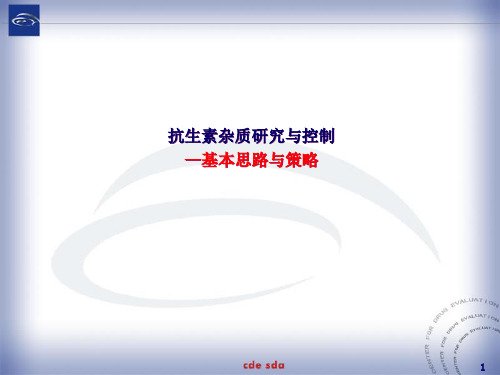
1
杂质
•
任何影响药物纯度的物质统称为杂质。
-原料药中不属于原料药的任何成分。
•
-制剂中不属于原料药或辅料的任何成分。
无治疗作用、影响药物稳定性和疗效、甚至对人体健康有害„ Fanconi征候群现象—差向四环素、脱水四环素以及脱水差向四环素
N-甲基硫四唑(MTT)—引起血液凝固疾病及戒酒硫样反应
11
降 解 产 物
特定 结构 单元
杂质谱概念的引入,进一步厘清了抗生素杂质 研究与控制的基本思路
以终为始
以源为始
避免了高风险杂质失控
被动控制
主动控制
实现了杂质的根本控制
个别控制
系统控制
全面掌控各种潜在杂质
12
杂质谱分析—由“以终为始”到“以源为始”
案例:基于杂质谱分析,四个具有遗传毒性警惕结构的潜在杂质 需要高度关注,但最初建立的分析方法未全部检测到,鉴于其风 险程度,重新建立针对性方法检出,在毒理学评估基础上,进行 了严格控制(杂质对照品法,ppm水平)。
了结构推断。
杂质谱分析--从杂质结构及制备工艺入手分析其来源。 从反应条件与杂质含量的关联性研究为切入点,研究确定了
工艺控制要素,在过程控制阶段从根本上把控产品质量。
15
超鉴定限度杂质的结构推断
Cl
O
H
CO2Na
N O
CH3 O
F NH H
N S
H CH3 CH3
493.9,
493.847
13
杂质谱分析—由“被动控制”到“主动控制”
案例:FLQMS有关物质的研究与控制 改进:普通C18柱、等度洗脱 结果:检出两个高含量杂质。 特定C18柱、梯度洗脱
制订抗生素有关物质质量标准的指导原则
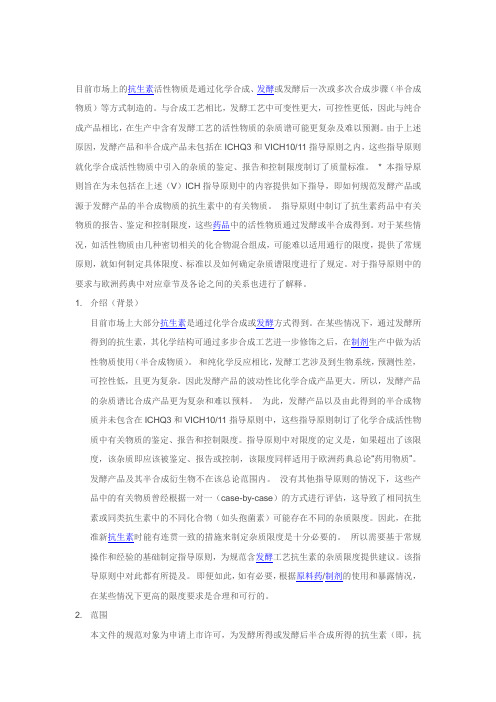
物质)等方式制造的。
与合成工艺相比,发酵工艺中可变性更大,可控性更低,因此与纯合成产品相比,在生产中含有发酵工艺的活性物质的杂质谱可能更复杂及难以预测。
由于上述原因,发酵产品和半合成产品未包括在ICHQ3和VICH10/11指导原则之内,这些指导原则就化学合成活性物质中引入的杂质的鉴定、报告和控制限度制订了质量标准。
* 本指导原则旨在为未包括在上述(V)ICH指导原则中的内容提供如下指导,即如何规范发酵产品或源于发酵产品的半合成物质的抗生素中的有关物质。
指导原则中制订了抗生素药品中有关况,如活性物质由几种密切相关的化合物混合组成,可能难以适用通行的限度,提供了常规原则,就如何制定具体限度、标准以及如何确定杂质谱限度进行了规定。
对于指导原则中的要求与欧洲药典中对应章节及各论之间的关系也进行了解释。
1. 介绍(背景)性物质使用(半合成物质)。
和纯化学反应相比,发酵工艺涉及到生物系统,预测性差,可控性低,且更为复杂。
因此发酵产品的波动性比化学合成产品更大。
所以,发酵产品的杂质谱比合成产品更为复杂和难以预料。
为此,发酵产品以及由此得到的半合成物质并未包含在ICHQ3和VICH10/11指导原则中,这些指导原则制订了化学合成活性物质中有关物质的鉴定、报告和控制限度。
指导原则中对限度的定义是,如果超出了该限度,该杂质即应该被鉴定、报告或控制,该限度同样适用于欧洲药典总论“药用物质”。
发酵产品及其半合成衍生物不在该总论范围内。
没有其他指导原则的情况下,这些产品中的有关物质曾经根据一对一(case-by-case)的方式进行评估,这导致了相同抗生素或同类抗生素中的不同化合物(如头孢菌素)可能存在不同的杂质限度。
因此,在批在某些情况下更高的限度要求是合理和可行的。
2. 范围本文件的规范对象为申请上市许可,为发酵所得或发酵后半合成所得的抗生素(即,抗细菌物质)中的有关物质制定标准。
未来可能将把范围扩大到其他抗生素(如抗真菌物质)。
抗生素标准品的建立制备原则
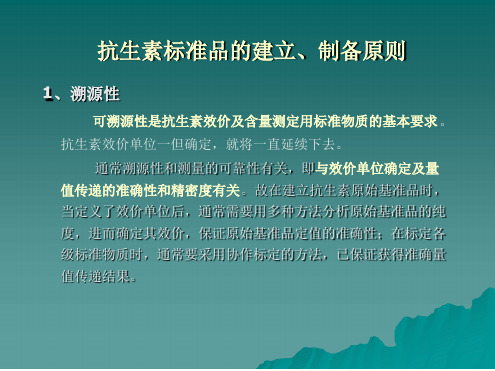
1、溯源性
可溯源性是抗生素效价及含量测定用标准物质的基本要求 。 抗生素效价单位一但确定,就将一直延续下去。
通常溯源性和测量的可靠性有关,即与效价单位确定及量 值传递的准确性和精密度有关。故在建立抗生素原始基准品时, 当定义了效价单位后,通常需要用多种方法分析原始基准品的纯 度,进而确定其效价,保证原始基准品定值的准确性;在标定各 级标准物质时,通常要采用协作标定的方法,已保证获得准确量 值传递结果。
Minocycline
2、无明确溯源的 —如:新药注册中的仿制药:地红霉素、司丙红霉素、头孢吡肟等。
(1)、根据世界卫生组织(WHO)基准品建立的指导原则,采用 多种测试分析方法,分析确定原料的纯度和杂质的含量。以扣除 法确定原料的含量。
(2)、在可以得到企业标准品/对照品或原始发明厂的标准品/对照 品的情况下:
a、以企业的标准品/对照品为对照,进行标定。验证方法(1)的结 果。
b、原始发明厂的标准品/对照品或以有明确溯源的标准品为基准进 行协作标定。
(3)在确定首批标准品、对照品的量值中,一般采用将方法(1) 的结果与标定结果合并计算,作为首批标准品/对照品的含量。或 以方法(2)结果核对或校正方法(1)结果,即可验证方法(1) 结果的准确性,又不侵犯知识产权。
3、无量值溯源 —新药注册中的国家一类新药,如头孢硫脒
头孢硫眯是我国自主研制的国家一类新药。在世界卫生组织 (WHO)基准品建立的指导下,结合我室多年来根据建立首批标准 品/对照品的经验,按照“基准品效价定义→组成分析→纯度分析→ 含量确定→结果验证”的基本步骤,研制建立国首批基准品。如:力 达霉素、安妥沙星、卡德沙星等基准品。
? 仿制品种标准物质的效价单位应与该品种原始发明国 家标准物质的效价单位一致。
- 1、下载文档前请自行甄别文档内容的完整性,平台不提供额外的编辑、内容补充、找答案等附加服务。
- 2、"仅部分预览"的文档,不可在线预览部分如存在完整性等问题,可反馈申请退款(可完整预览的文档不适用该条件!)。
- 3、如文档侵犯您的权益,请联系客服反馈,我们会尽快为您处理(人工客服工作时间:9:00-18:30)。
30 June 2012EMA/CHMP/CVMP/QWP/199250/2009 corrCommittee for Medicinal Products for Human Use (CHMP)/ Committee for Medicinal Products for Veterinary Use (CVMP)Guideline on setting specifications for related impurities in antibiotics抗生素中相关杂质质量标准制定的指导原则Final 定稿学习之名(译注)Table of contents 目录Executive summary1. Introduction (background)2. Scope3. Legal basis4. General requirements5. Impurity profiling and reporting, identification and qualification thresholds6. New applications and variations7. Specifications for medicinal products8. Analytical proceduresDefinitionsAnnex 1: Explanatory note regarding thresholds.Annex 2: ThresholdsAnnex 3: Example of “fingerprint chromatogram” approach to control very complex impurity profiles 概要1、背景介绍2、范围3、法规依据4、一般要求5、杂质分布以及报告、鉴别和界定阈值6、新申请和变更7、制剂产品质量标准8、分析方法定义附件1:关于阈值的注释附件2:阈值附件3:利用基于“指纹图谱”的方法对非常复杂的杂质分布进行控制举例Executive summary 概要Antibiotics active substances currently on the market are produced by fermentation, by fermentation followed by one or more synthetic steps (semi-synthetic substances) or by chemical synthesis. Fermentation processes are, in comparison to synthetic processes, more variable and less controllable, so the impurity profile of an active substance whose manufacturing process involves fermentation may be more complex and less predictable than that of a purely synthetic product. For this reason fermentation products and semi-synthetic substances are not included in the scope of the ICH Q3 and the VICH GL10/GL11 guidelines, which set thresholds for the identification, reporting and qualification of related impurities in active substances manufactured by chemical synthesis.目前上市的抗生素类活性物质是由发酵、发酵加一步或几步合成步骤(半合成)、化学合成制得。
与合成工艺相比,发酵工艺更具多变性,不易控制,因此与单纯使用化学合成生产的产品相比,生产工艺含有发酵步骤的活性物质的杂质分布一般比较复杂和难以预测。
基于此原因,发酵产品和半合成产品并不适用于ICH Q3和VICH GL10/GL11指南。
因为这两个指南适用于由化学合成生产的活性物质。
This guideline has been developed in order to provide guidance on how specifications for related impurities in antibiotics that are fermentation products or semi-synthetic substances derived from fermentation products, and are therefore not included in the scope of the (V)ICH guidelines mentioned above, should be set.本指南旨在为不适用于ICH Q3指南的发酵产品或源于发酵产品的半合成物质中杂质质量标准的设定提供指导。
Thresholds are given in the guideline for reporting, identification and qualification of related impurities for antibiotics medicinal products whose active substance is produced by fermentation or semi- synthesis. In cases where the active substance consists of a mixture of closely related compounds, where it may be difficult to apply general thresholds, general guidance is given on how to set specific thresholds and specifications and on how to qualify impurity profiles. The relationships between the requirements in the guideline and the applicable Ph.Eur. chapters and monographs are also addressed. 对于活性成分为发酵或半合成来源的抗生素制剂产品的相关杂质,本指南给出了报告、鉴定和界定阈值。
在活性物质由多个密切相关的化合物混合组成情况下,对其应用一般的阈值存在困难。
针对此,本指南就如何设定阈值和如何论证杂质分布给出了指导。
对于本指南与欧洲药典要求的关系,本指南也做了阐述。
注:界定限(界定阈值):指超过该限度的杂质需进行论证,包括安全性、设定的限度合理性等。
1. Introduction (background)背景介绍Most of the antibiotics currently on the market are produced by fermentation or chemical synthesis. In certain cases the chemical structure of the antibiotics obtained by fermentation is further modified by some synthetic steps, before the substance is used as an active substance in the manufacture of medicinal products (semi-synthetic substances).目前市售的大多数抗生素是由发酵或化学合成生产的。
一些情况下,由发酵生产的抗生素在可用作生产制剂的活性成分前,其结构会经过一些合成步骤进行修改(半合成物质)Fermentation processes involve biological systems which are less predictable, less controllable and more complex than straightforward chemical reactions. Because of this, the variability in products derived by fermentation is often greater than in products derived by chemical synthesis. Thus, the impurity profile of a fermentation product may be more complex and less predictable than that of a synthetic product.与直接化学方应相比,发酵工艺包含不易预测、控制和复杂的生物系统,发酵产品比化学合成产品更具多变性。
因此,发酵产品的杂质分布会比化学合成产品的更复杂和不易预测。
For this reason, fermentation products and semi-synthetic substances derived from them are notincluded in the scope of the ICH Q3 and the VICH GL10/GL11 guidelines that set thresholds for the identification, reporting and qualification of related impurities in active substances manufactured by chemical synthesis. These thresholds are defined in the guidelines as limits above which an impurity has to be either identified, reported or qualified, and the same limits are applied in the Ph.Eur. general monograph ‘Substances for Pharmaceutical Use’. Fermentation products and their semi synthetic derivatives are also excluded from the scope of this general monograph.基于此,发酵产品和源于发酵产品的半合成物质并不适用于ICH Q3和VICH GL10/GL11。
